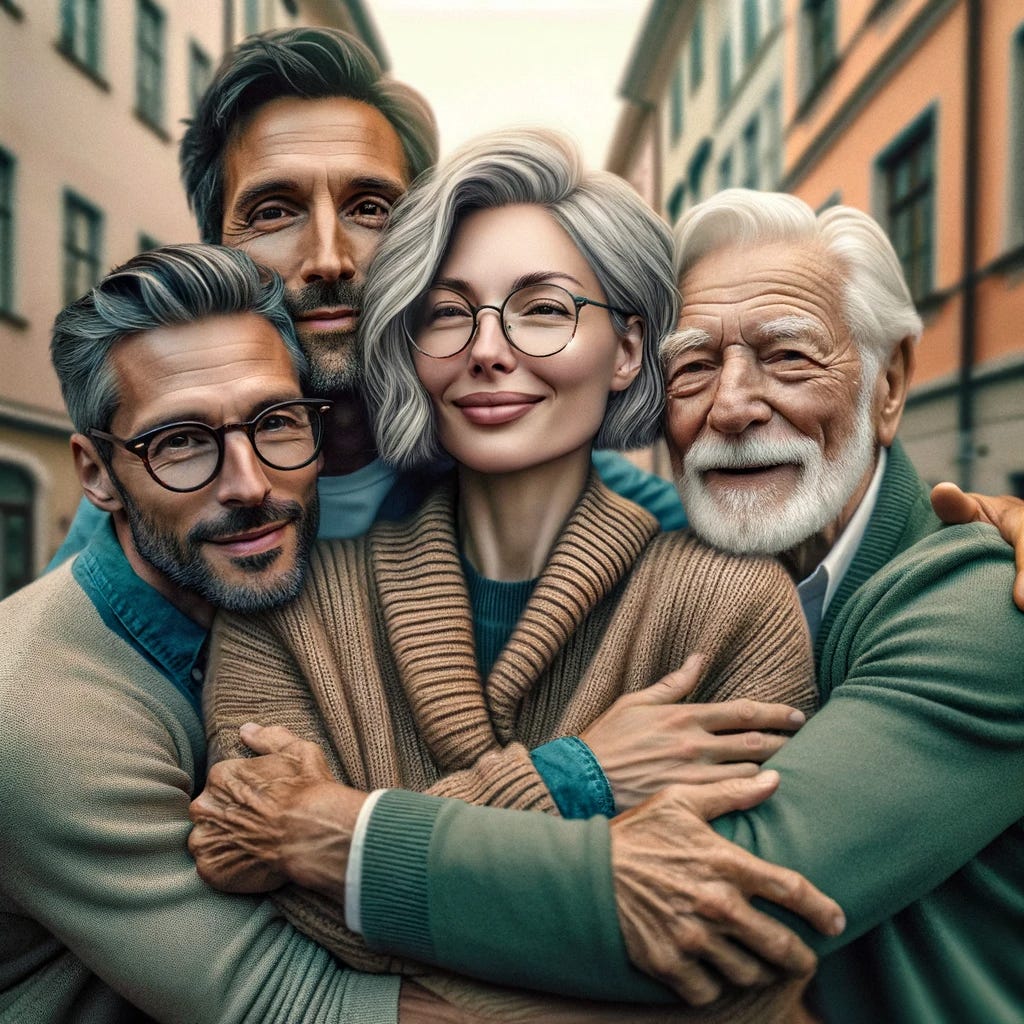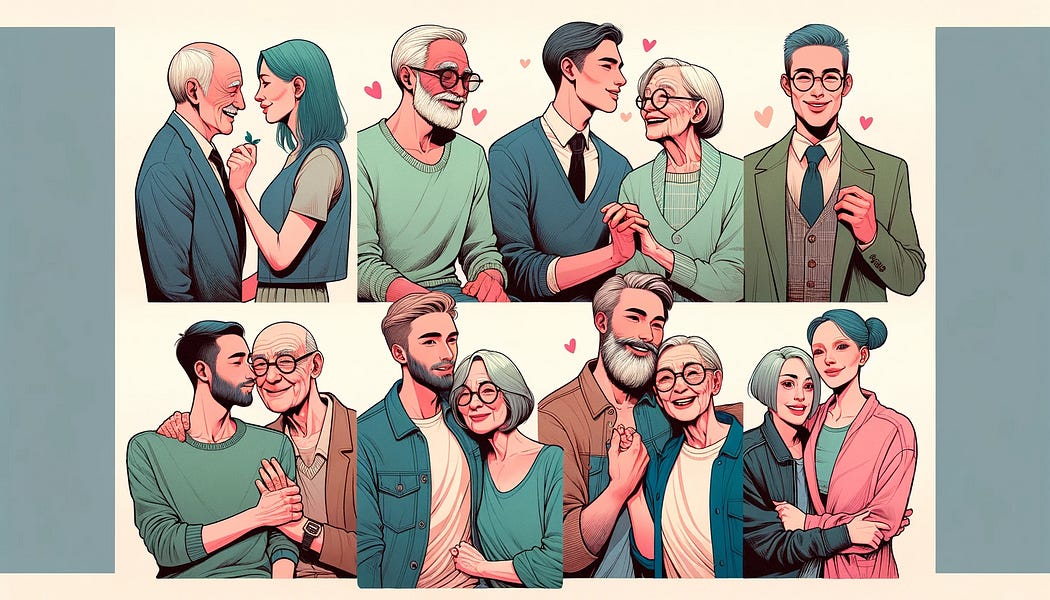Designing Love Across Ages: The Conscious Craft of Age-Gap Relationships
Taking a fresh look at age-gap relationships through the lens of Conscious Relationship Design, this piece unearths the rich potential for authentic connection and intentional growth in modern love.
In a quaint town, where the whispers of the wind carried tales into every ear, lived “Margaret”, a spirited woman of 54, whose love life defied long-held conventions.* Happily married for decades, Margaret’s heart and life had made room for two more companions, one 20 years her senior and the other 20 years her junior.
There was “Albert”, 74, a retired professor whose zest for life was as invigorating as a spring morning. Despite his age, he carried a youthful spirit that found joy in the thrill of the new. He was known in his social circles as someone who defied the customary boundaries of age, embracing the modern with a curious mind. Their meetings were lively and energetic, filled with spirited debates that explored life’s intricacies, yet also touched on the latest indie rock bands and the newest fusion cuisine eateries in town. As someone who believed that learning was a lifelong adventure, Albert frequently attended workshops on emerging technologies, and was even known to dabble in street art during the weekends. Their rendezvous were a blend of the profound and the playful, accompanied by the eclectic beats of contemporary music and the sweet, fruity notes of newly discovered wines from a local organic vineyard. Each encounter with Albert was an invitation for Margaret to view the world through a lens that was as modern and open as it was wise and seasoned.
Margaret had met “Henry”, 34, at a local tango dancing class. Their first dance was a conversation without words, a rhythmic exploration that continued long after the music stopped. With Henry, she rediscovered the vivacity of youth, their laughter ringing through the many evenings they spent together, dancing or simply sharing dreams under a canopy of stars. Henry, a budding novelist with a penchant for adventure, brought a touch of whimsy into her life. His eyes sparkled with the boundless curiosity of a writer whose world was framed by the dance of imagination and reality. Together, they explored the city’s hidden bookstores, dined in quaint little bistros, and shared their love for the poetic rhythm of tango under the soft glow of the moonlight. Their relationship was a beautiful blend of youthful enthusiasm and shared intellectual pursuits, a journey that constantly uncovered new layers of companionship and mutual understanding. Each moment with Henry was a lovely reminder to Margaret of the endless possibilities that lay ahead, the potential for rediscovering a youthful perspective while also engaging in meaningful, mature conversations that touched the soul.
Her husband, “John”, was her anchor, and her primary. Their love was like an old, comforting tune, resonating through the years, each note a sweet reminder of a life well lived together. John, a seasoned architect, was a man of structure and stability. His hands, which once sketched dreams onto blueprints, now often found comfort in the old leather-bound books that filled their home library. His mind was a rich tapestry of historical knowledge and contemporary insights, always ready to explore the realms of philosophy over a cup of gently brewed coffee. Their weekends were often filled with the simple joy of riding bicycles through the nearby trails, exploring the serene countryside, laughing over a picnic under the clear sky. John, with his knack for photography, would capture the world through his lens, while Margaret often found herself immersed in the stories of the people they met along the way. Their evenings were spent cooking together, experimenting with recipes, and sharing the tales of the day. With John, Margaret found a kind of love that was steady and reassuring, a bond that grew stronger and stronger through the years.
Margaret’s unconventional tale was a soft yet daring defiance of, among other things, the age stereotypes that society often quietly hummed. The town whispered, but Margaret found her heart beating to a rhythm that was genuine and unapologetically unique.
Each relationship was a dance of souls, a harmonious container that celebrated the boundless capacities of love, understanding and the essence of Conscious Relationship Design. Margaret and her companions navigated through the unchartered with grace, understanding and hearts open to the endless possibilities that love presents, regardless of age.
As she sat by her window, John at her side, a book of modern poetry in her lap, glancing now and then at the tango steps she’d jotted down, or lost in thought reflecting on her profound discussions with Albert, Margaret’s heart was full. The room was filled with the gentle cadence of John’s laughter as they shared a quiet joke, the memory of Henry’s youthful exuberance as they spun around the dance floor, and the intellectual stimulation of her debates with Albert. Each relationship was a unique melody, and together they composed the symphony of her life, a living testament to the boundless capacities of love and the essence of Conscious Relationship Design.
*This is a true story. Names and details have been changed to protect the identity of those involved. Ages have not been changed.
Older men, younger women; older women, younger men: It’s a thing
Age-gap romantic relationships, often termed May-December relationships, are romantic engagements where there’s a significant age difference between partners. The age difference can range from a decade to over 30 years. These relationships are not a new phenomenon, yet they evoke a myriad of reactions and judgments, largely rooted in societal norms and expectations.
Society often views age-gap relationships through a lens of scepticism or intrigue. Common stereotypes include a presumption of inherent power imbalances, or assumptions about the motivations of the individuals involved, often reducing the relationship to a narrative of financial security versus physical attraction. These cliched narratives overlook the multifaceted connections and mutual growth that can thrive in such relationships, much like any other.
Conscious Relationship Design (CRD) dismantles traditional relationship paradigms, urging individuals to engage in relationships with a heightened level of awareness, intentionality and commitment to open communication and co-creation. By applying the principles of CRD, individuals both in and outside age-gap relationships can dissect societal prejudices, explore their interpersonal dynamics with a lens of curiosity and cultivate relationships rooted in mutual respect, understanding and growth.
Through the deliberate design of a couple’s (or group’s) relational dynamics, age-gap relationships can transcend societal judgments, blossoming into nurturing, enriching and enduring companionships. And the people around them? Can learn from these relationships and take the best part of their lessons into their own couples and relationships.
In this article, we will delve into the dynamics of age-gap relationships, untangling conventional stereotypes and unveiling the potential for profound connection, love and healthy relationships among people decades apart. We will use the lens of Conscious Relationship Design to help us do so.
It’s a thing that works
Research unveils some surprising findings when it comes to age-gap relationships. Despite societal prejudices, these relationships often exhibit satisfying and enduring qualities. For instance, research published by Justin Lehmiller and Christopher Agnew in 2011 cited results that revealed that an age gap in which a husband was older than a wife was associated with increases in life satisfaction for both men and women. In addition to increased life satisfaction, research suggests age-gap relationships fare well in other regards. For instance, age-gap partners appear to be more trusting, less jealous, and less selfish in their relationships compared to persons who are more similar in age to their romantic partners.
The relationship between French President Emmanuel Macron and his wife, Brigitte Macron, presents a real-world example that challenges societal norms with its 25-year age difference. Their relationship began when Emmanuel was a 15-year-old student, and Brigitte, married at the time, was his drama teacher. Over time, their union has persisted, illustrating a solid narrative of deep connection and enduring love that defies conventional expectations. Through their public persona, they demonstrate the potential for age-gap relationships to thrive amidst societal scrutiny, serving as a testament to relationship stability and companionship across age divides.
Additionally, the representation of age-gap relationships in mainstream media reflects evolving societal attitudes. The term MILF, an acronym for “Mother I’d Like to (have sexual relations with),” often symbolises the allure of older women to younger men. One of the early media portrayals exploring this dynamic is the 1967 film “The Graduate,” wherein Mrs. Robinson, an older woman, seduces a younger man (Dustin Hoffman). This theme has carried into contemporary culture, with reality shows like “MILF Manor” humorously delving into relationships between older women and younger men, suggesting a shift, albeit lighthearted, in societal attitudes towards age-gap relationships. This change in media representation perhaps mirrors a broader societal acceptance, or at least curiosity, towards exploring romantic connections beyond the bounds of age.
Societal evolution significantly influences the perception of age-gap relationships. The traditional view sees age as a power differential, making age-gap relationships prone to exploitation by the older partner. However, evolving societal norms are beginning to challenge these traditional narratives. The role of gender, for instance, is increasingly recognised in shaping perceptions, where older men paired with younger women are seen differently than older women with younger men.
In some ways, societal norms and gender dynamics are changing, and in some ways, they are not. The question becomes are they changing enough to gradually reshape the discourse surrounding age-gap relationships — so as to pave the way for a more nuanced understanding and acceptance of such relationships?
It’s not a new thing
In days past, love wasn’t always a matter of heartbeats and sweet whispers; sometimes, it was a calculated decision to merge resources, elevate social standing, or fulfil societal expectations. Age-gap relationships, where a noticeable number of years separate the partners, were commonplace. The age disparity often reflected economic necessity or social stratagem rather than personal preference.
Older men, with their lives somewhat figured out and their pockets a bit fuller, would offer their hand to younger women whose families saw an advantageous union. Similarly, women of higher social standing or wealth might find younger suitors seeking their favour. These relationships were less about romantic love and more about social survival and climbing the societal ladder.
But as time passed, societies modernised, and stiff traditional norms began to slacken. The emergence of nuclear families, the fight for women’s rights, and the softening of societal expectations gradually reshaped the landscape of love and marriage. Now, the heart took precedence over age, and love began blooming in gardens where age was but a number.
Yet, despite this modern era of romantic enlightenment, the shadows of old norms sometimes linger, casting doubts and stigmas on age-gap relationships. The modern lens often views these relationships with a mix of intrigue and scepticism (if you don’t believe me, go back up and read the story that opened this article).
Interestingly, the acceptance and prevalence of age-gap relationships still vary widely across different cultures. In some corners of the globe, the traditional norms hold firm and age-gap relationships continue to be quite common. For instance, certain African and Middle Eastern cultures often see older men engaging in relationships with younger women positively. On the flip side, the Western world, with its rapid pace of social evolution, presents a mixed bag of attitudes.
The legal frameworks and media portrayal of age-gap relationships also significantly impact societal attitudes (as we’ve briefly seen above). The screen, big and small, has become a mirror reflecting societal attitudes toward age-gap relationships. Yet, it also serves as a window to different possibilities, nudging society towards broader acceptance.
But as we sift through the layers of past norms, present attitudes and the diverse cultural tapestry, we realise that age-gap relationships are not a modern anomaly but a historical norm. It’s the attitudes towards them that have evolved. And perhaps, as we glide through the modern era of individual choice and emotional connections, the essence of relationships, age-gap or not, boils down to the genuine connection between the hearts that beat for each other — and I would offer, the conscious design of their containers and parameters in which to hold and conduct them.
Is it a bad thing?
In light of this, the psychology of age-gap relationships merits a deeper exploration, one that transcends the superficial to consider the foundational elements that foster genuine connection. Research upends the common myth that these relationships are inherently imbalanced, revealing instead a landscape where trust, satisfaction and mutual respect can flourish. This empirical evidence challenges the stereotype of age-gap partnerships as breeding grounds for exploitation, suggesting a narrative replete with examples of harmony and equitable partnership.
Moreover, the criteria for predatory behaviour — exploitation, manipulation and a marked power imbalance — are not the cornerstones of age-gap relationships but are, unfortunately, potential risks in any romantic engagement, regardless of the ages involved. The key distinction lies in the dynamics of power and consent; where these are balanced and mutually agreed upon, the relationship stands on firm ground.

This discrepancy between perception and reality calls for a recalibration of our societal lens, urging a more empathetic and evidence-based understanding of age-gap relationships. It beckons us to cast off the yoke of age-related prejudice and acknowledge the myriad ways in which love can manifest, often defying expectations and societal norms. It’s in the conscious crafting of these relationships — where individuals navigate the complexities of their union with intention, communication and respect — that the true essence of a partnership is found, unbound by the years separating their births.
So, as we advance in our narrative, it becomes clear that the heart of the matter is not so much the age gap itself but the quality of the connection and the deliberate design of a relationship’s framework. In this light, age-gap relationships can be seen not as societal outliers but as another expression of the diverse spectrum of human love, where the success of a partnership is measured not by the years, but by the depth of the bond and the conscious choices made by those within it.
How do we consciously design age-gap relationships?
Age-gap relationships often face unique challenges that stem from societal preconceptions (as seen above) and the inherent differences in life experiences between partners. Conscious Relationship Design (CRD) can be a transformative approach to navigating these obstacles, emphasising intentionality and mutual growth.
Applying CRD principles
First, CRD encourages partners to engage in profound self-awareness exercises, acknowledging the impact of their age difference on individual desires, limitations and future aspirations. This internal clarity becomes the bedrock upon which partners can construct an understanding of how their age gap specifically influences their dynamic.
Second, leveraging open and non-judgmental communication, a cornerstone of CRD, partners in age-gap relationships can articulate their needs and boundaries more effectively. This exchange fosters an environment where both individuals feel heard and respected, regardless of their age.
Third, CRD advocates for continuous re-evaluation and evolution of relationship agreements. This iterative process is particularly beneficial for age-gap relationships where partners may undergo significant personal changes at different times, due to the distinct stages of life they are in.
Communication strategies for addressing societal judgments
Societal judgments can weigh heavily on age-gap relationships, but CRD offers robust communication strategies to counteract this external pressure.
First, it suggests reframing the narrative by highlighting the relationship’s conscious design elements, which often include an explicit commitment to growth, empathy, and mutual respect — values that transcend age.
Second, CRD recommends proactive boundary setting with the social sphere. This could involve deciding as a unit/group which critiques to address and which to let pass, thus preserving the relationship’s sanctity from corrosive societal opinions.
Third, it’s about creating an alliance that values internal validation over external perceptions, fostering a relationship culture where the primary concern is the well-being and satisfaction of the partners, not the approval of outsiders.
Case studies
To illustrate CRD in action within age-gap relationships, consider the following anonymised cases:
Case Study 1: “Mia” (26) and “James” (47) navigate their 21-year age difference by establishing a ritual of monthly check-ins to explore, play with and discuss their evolving needs and how they perceive their relationship in the context of their individual life goals. They consciously design their future with flexibility, allowing room for Mia’s career development and her thoughts around having children and James’ transition into a new creative endeavour.
Case Study 2: “Liam” (81) and “Evan” (45) confront societal scrutiny by uniting under a shared vision of their relationship. They have developed a practice of mutual mentorship, where Liam shares his life wisdom, while Evan brings fresh perspectives and vitality. They credit CRD with providing them the tools to build a relationship that is not only resilient to external judgment but also emotionally and intellectually fulfilling.
Case Study 3: “Sophie” (64) and “Aaron” (44) demonstrate how age-gap couples can successfully integrate different life stages into a cohesive partnership. They designed their relationship with a focus on autonomy and growth, allowing Aaron to embrace a major career change later in life while supporting Sophie’s pursuit of self-exploration and expression through travel and further education.
These case studies exemplify how the principles of CRD can be applied to age-gap relationships, transforming potential areas of conflict into opportunities for deeper connection and understanding. By consciously designing their relationships, these couples are creating partnerships that are resilient, adaptive and above all, centred on mutual love and respect.
Wait. Consciously designing relationships? What will that do to us?!
The transformative power of education emerges as we delve into Conscious Relationship Design, which at its core, challenges age-old stereotypes with a fresh perspective. It’s a matter of igniting dialogues, inspiring minds to critically engage with, and dissolve the preconceived notions that have long cast a shadow over the legitimacy of modern love’s diverse forms and expressions.
Peering into the future, we discern not just transient trends but a foundational shift in the very architecture of relationships. As society becomes more accepting of diverse relationship forms, age disparities may become less significant in the public eye. This evolution could be accelerated by prominent examples in media and increased visibility of successful age-gap relationships that exhibit a healthy dynamic rooted in CRD principles. The trend towards later-life re-partnering, driven by longer life expectancies and a focus on personal fulfilment across life phases, may also contribute to a rise in such partnerships.
The advocacy for conscious, intentional relationship design transcends the boundaries of age, advocating for a paradigm where relationships are artfully crafted, not haphazardly stumbled upon. This growing consciousness paves the way for potential transformations in legal and social frameworks, creating a more hospitable environment for all forms of partnership, including those with significant age disparities. As advocates among us highlight the imperative of self-awareness, communication, consent and intention, we champion the creation of bespoke bonds, tailored to the intricate — and evolving — tapestry of individual desires and circumstances. This movement is about endorsing diversity, yes. It’s also about dismantling the monolithic constructs of relationships burned into our minds, celebrating the unique and custom-designing love that defies a one-size-fits-all approach.
The takeaway
The narratives and research shared here echo the sentiment that age-gap relationships, when intentionally designed and consciously maintained, can flourish into exemplars of companionship and mutual growth.
This journey calls for a more nuanced understanding of age-gap relationships, urging an appreciation for the diverse experiences and wisdom such partnerships offer. The thread of CRD weaves through each story, proposing a framework not just for age-gap lovers but for all relationships aspiring to be rooted in authenticity and purposeful growth.
With the insights gleaned, I invite you to explore, share and advocate for the principles of CRD. Whether it’s through fostering open dialogues, questioning conventional norms and how well they’re working for us, or simply embracing the infinite forms love and relationships can take, we all have a role in nurturing a society where relationships are celebrated for their essence rather than judged by their structure.
What do you think?
But what are your thoughts? How do you perceive the tapestry of age-gap relationships within the grander mosaic of society? Do these narratives resonate with you, challenge you or inspire you to redesign the blueprint of your own relationships? Your insights are invaluable, and I encourage you to reach out, share your stories and contribute to this dialogue. I’d love to hear from you!
Additional resources
May-December Paradoxes: An Exploration of Age-Gap Relationships in Western Society by Justin Lehmiller and Christophe Agnew (2011).
This work is a piece from my current writing project on Conscious Relationship Design. If you’d like to read along and follow more, hit the “subscribe” button to get a notification when I publish new articles on this topic.
Feel free to share this article if you enjoyed it. Comment or reach out if you’d like to share your thoughts. I’d love to hear from you.


















